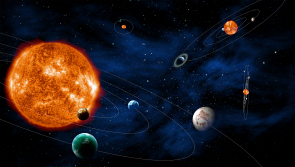Construction of Europe's exoplanet hunter PLATO begins
4 October 2018
The construction of ESA's PLATO mission to find and study planets beyond our Solar System will be led by Germany's OHB System AG as prime contractor, marking the start of the full industrial phase of the project. |
| Searching for exoplanetary systems. Credit: ESA/C. Carreau |
The announcement was made today at the 69th International Astronautical Congress in Bremen, Germany, where the contract was formally signed.
The contract covers the delivery of the satellite, including the testing phase leading to launch, support during the launch campaign, and the in-orbit commissioning phase.
PLATO, the PLAnetary Transits and Oscillations of stars mission, will be launched in 2026 to find and study extrasolar planetary systems, with a special emphasis on rocky planets around Sun-like stars and their habitable zone – the distance from a star where liquid water can exist on a planet's surface.
"Does a second Earth exist in the Universe? is one of the exciting questions in astrophysics today," says Johann-Dietrich Wörner, Director General of ESA.
"With our PLATO satellite we are focusing on Earth-like planets orbiting up to the habitable zone around other stars which are similar to our Sun. This will be a major step towards finding another Earth."
The spacecraft will be built and assembled by OHB together with Thales Alenia Space (France and the UK) and RUAG Space Switzerland; many ESA member States will also be involved in the construction of this European planet hunter.
The German Aerospace Center (DLR) and a consortium of various European research centers and institutes will provide the scientific instrument, consisting of an array of 26 cameras and electronic units, that will observe a large patch of the sky on the lookout for planets.
"PLATO is a next-generation exoplanet mission that will monitor thousands of bright stars over a large area of the sky in search of tiny, regular dips in their brightness caused by transiting planets," says Ana Heras, PLATO Project Scientist at ESA.
"Since planets only block a minute portion of the light radiated by their parent star, this quest requires extremely precise, long-term photometric observations."
PLATO will not only seek new planets but will also investigate the properties of their host stars, and determine the planetary masses, sizes and ages with unprecedented accuracy. This will help scientists understand the architecture of exoplanet systems and determine whether they might host habitable worlds. In addition, PLATO will also perform asteroseismology – the study of seismic activity of stars – providing insight into stellar interiors and evolution.
The mission will expand on the work of Cheops, ESA's upcoming exoplanet watcher, which will be launched next year to perform a first characterization of known planets. It will be followed by Ariel, scheduled for launch in 2028, which will observe a large and diverse sample of exoplanets to study their atmospheres in great detail.
PLATO will operate from the 'L2' virtual point in space 1.5 million km beyond Earth as seen from the Sun. From this vantage point, it will be our outpost to unravel the mysteries of a multitude of extrasolar worlds.
"We are pleased to kick off construction of this exciting mission," says Filippo Marliani, ESA's PLATO Project Manager.
"With the prime contractor and the support of European space industry, we are looking forward to building a spacecraft that will tackle some of humankind's most profound questions."
Notes for editors
PLATO, or PLAnetary Transits and Oscillations of stars, is the third medium-class mission in ESA's Cosmic Vision programme. Its objective is to find and study a large number of extrasolar planetary systems, with emphasis on the properties of terrestrial planets in the habitable zone around solar-like stars. PLATO has also been designed to investigate seismic activity in stars, enabling the precise characterisation of the planet host star, including its age.
For further information, please contact:
Markus Bauer
ESA Science and Robotic Exploration Communication Officer
Tel: +31 71 565 6799
Mob: +31 61 594 3 954
Email: markus.bauer![]() esa.int
esa.int
